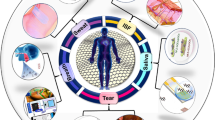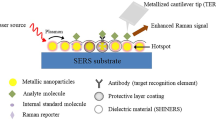Abstract
We design a surface plasmon resonance (SPR) molecular sensor based on graphene and biomolecule adsorption at graphene–liquid interfaces. The sensor configuration consists of two opposing arrays of graphene nanograting mounted on a substrate, with a liquid-phase sensing medium confined between them. We characterize the design in simulation on a variety of substrates by altering the refractive index of the sensing medium and varying the absorbance–transmittance characteristics. The influence of various parameters on the biosensor’s performance, including the Fermi level of graphene, the dielectric constant of the substrate, and the incident angle for plasmon excitation, is investigated. Numerical simulations demonstrate the sensitivity higher than 3000 nm/RIU (refractive index unit). The device supports a wide range of substrates in which graphene can be epitaxially grown. The proposed biosensor works independent of the incident angle and can be tuned to cover a broadband wavelength range.






Similar content being viewed by others
References
D. Rodrigo, O. Limaj, D. Janner, D. Etezadi, F.J. García de Abajo, V. Pruneri et al., Mid-infrared plasmonic biosensing with graphene. Science 349(6244), 165–168 (2015)
H. Hu, X. Yang, F. Zhai, D. Hu, R. Liu, K. Liu et al., Far-field nanoscale infrared spectroscopy of vibrational fingerprints of molecules with graphene plasmons. Nat. Commun. 7, 12334 (2016)
H.T. Chorsi, S.D. Gedney, Efficient high-order analysis of bowtie nanoantennas using the locally corrected Nystrom method. Opt. Express 23(24), 31452–31459 (2015)
B. Liedberg, C. Nylander, I. Lunström, Surface plasmon resonance for gas detection and biosensing. Sens. Actuators 4, 299–304 (1983)
P. Adam, J. Dostálek, J. Homola, Multiple surface plasmon spectroscopy for study of biomolecular systems. Sens. Actuators B 113(2), 774–781 (2006)
C.-J. Huang, J. Dostalek, A. Sessitsch, W. Knoll, Long-range surface plasmon-enhanced fluorescence spectroscopy biosensor for ultrasensitive detection of E. coli O157:H7. Anal. Chem. 83(3), 674–677 (2011)
A.N. Grigorenko, M. Polini, K.S. Novoselov, Graphene plasmonics. Nat. Photon 6(11), 749–758 (2012)
H.T. Chorsi, M.T. Chorsi, X.J. Zhang, Using graphene plasmonics to boost biosensor sensitivity. SPIE Biomed. Opt. Med. Imag. (2016). https//doi.org/10.1117/2.1201610.006712
D. Wei, Y. Liu, Y. Wang, H. Zhang, L. Huang, G. Yu, Synthesis of N-doped graphene by chemical vapor deposition and its electrical properties. Nano Lett. 9(5), 1752–1758 (2009)
V.P. Gusynin, S.G. Sharapov, J.P. Carbotte, Magneto-optical conductivity in graphene. J. Phys. Condens. Matter 19(2), 026222 (2007)
T. Holmgaard, S.I. Bozhevolnyi, Theoretical analysis of dielectric-loaded surface plasmon-polariton waveguides. Phys. Rev. B 75(24), 245405 (2007)
J. Hu, X. Sun, A. Agarwal, L.C. Kimerling, Design guidelines for optical resonator biochemical sensors. J. Opt. Soc. Am. B 26(5), 1032–1041 (2009)
J. Homola, S.S. Yee, G. Gauglitz, Surface plasmon resonance sensors. Sens. Actuators B 54(1), 3–15 (1999)
Acknowledgements
The authors thank Prof. John X.J. Zhang from Dartmouth College and Prof. Stephen D. Gedney from the University of Colorado Denver for the fruitful discussion and guidance.
Author information
Authors and Affiliations
Corresponding author
Rights and permissions
About this article
Cite this article
Chorsi, M.T., Chorsi, H.T. Graphene plasmonic nanogratings for biomolecular sensing in liquid. Appl. Phys. A 123, 757 (2017). https://doi.org/10.1007/s00339-017-1380-9
Received:
Accepted:
Published:
DOI: https://doi.org/10.1007/s00339-017-1380-9




